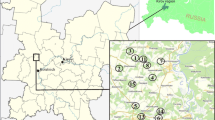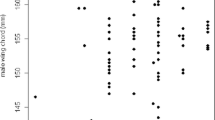Abstract
Previous sociobiological studies of tarsiers were invariably based on field observations. Sulawesi tarsiers are known for monogamous or facultative polygynous social mating systems, but, to date, no data exist to describe the genetic mating system. We here bring together behavioral studies and molecular tools for the first time to elucidate mating behavior and kinship within a tarsier population. We investigated the social system of the recently described Tarsius lariang, which researchers have never studied before. Between September and November 2005, we conducted field observations and sampling in central Sulawesi, Indonesia, where this species is endemic. Ten of 11 social groups of the focal population were composed of 1 adult male, 1 adult female, and putative offspring. To enlighten genetic relationships, we used 12 microsatellite loci and mitochondrial DNA sequences of 26 captured and sampled Lariang tarsiers for parentage and relatedness analyses. A significant number of young were the offspring of the sampled group adults, suggesting a predominantly monogamous social and genetic mating system. There is evidence for extrapair young in groups in which adult pairs exhibit close relationships, leading to the assumption that extrapair mating is solicited to avoid inbreeding. Ten of 11 social groups lived in monogamous social systems, indicating monogamy to be the rule in Tarsius lariang.

Similar content being viewed by others

References
Alberts, S. C., Altmann, J., & Wilson, M. L. (1996). Mate guarding constrains foraging activity of male baboons. Animal Behaviour, 51, 1269–1277. doi:10.1006/anbe.1996.0131.
Altmann, S. A. (1974). Baboons, space, time, and energy. American Zoologist, 14, 221–248.
Bearder, S. K. (1987). Lorises, bushbabies, and tarsiers: Diverse societies in solitary foragers. In B. B. Smuts, D. L. Cheney, R. M. Seyfarth, R. W. Wrangham, & T. T. Struhsaker (Eds.), Primate Societies (pp. pp. 14–24). Chicago: University of Chicago Press.
Bearder, S. K. (1999). Physical and social diversity among nocturnal primates: A new view based on long term research. Primates, 40, 267–282. doi:10.1007/BF02557715.
Blouin, M. S. (2003). DNA-based methods for pedigree reconstruction and kinship analysis in natural populations. Trends in Ecology & Evolution, 18, 503–511. doi:10.1016/S0169-5347(03)00225-8.
Brandon-Jones, D., Eudey, A. A., Geissmann, T., Groves, C. P., Melnick, D. J., Morales, J. C., Shekelle, M., & Stewart, C.-B. (2004). Asian primate classification. International Journal of Primatology, 25, 97–164. doi:10.1023/B:IJOP.0000014647.18720.32.
Brotherton, P. N. M., & Rhodes, A. (1996). Monogamy without biparental care in a dwarf antelope. Proceedings of the Royal Society of London. Series B. Biological Sciences, 263, 23–29. doi:10.1098/rspb.1996.0005.
Chapman, C. A., Wrangham, R. W., & Chapman, L. J. (1995). Ecological constraints on group size: An analysis of spider monkey and chimpanzee subgroups. Behavioral Ecology and Sociobiology, 36, 59–70. doi:10.1007/BF00175729.
Crompton, R. H., & Andau, P. M. (1987). Ranging, activity rhythms, and sociality in free-ranging Tarsius bancanus: A preliminary report. International Journal of Primatology, 8, 43–71. doi:10.1007/BF02737113.
Fuentes, A. (1998). Re-evaluating primate monogamy. American Anthropologist, 100, 890–907. doi:10.1525/aa.1998.100.4.890.
Fietz, J., Zischler, H., Schwiegk, C., Tomiuk, J., Dausmann, K. H., & Ganzhorn, J. U. (2000). High rates of extra-pair young in the pair-living fat-tailed dwarf lemur, Cheirogaleus medius. Behavioral Ecology and Sociobiology, 49, 8–17. doi:10.1007/s002650000269.
Goodman, M., Porter, C. A., Czelusniak, J., Page, S. L., Schneider, H., Shoshani, J., Gunnell, G., & Groves, C. P. (1998). Toward a phylogenetic classification of primates based on DNA evidence complemented by fossil evidence. Molecular Phylogenetics and Evolution, 9, 585–598. doi:10.1006/mpev.1998.0495.
Goossens, B., Graziani, L., Waits, L. P., Farand, E., Magnolon, S., Coulon, J., Bel, M.-C., Taberlet, P., & Allainé, D. (1998). Extra-pair paternity in the monogamous alpine marmot revealed by nuclear DNA microsatellite analysis. Behavioral Ecology and Sociobiology, 43, 281–288. doi:10.1007/s002650050492.
Greenwood, P. J. (1980). Mating systems, philopatry and dispersal in birds and mammals. Animal Behaviour, 28, 1140–1162. doi:10.1016/S0003-3472(80)80103-5.
Gursky, S. (1995). Group size and composition in the Spectral tarsier, Tarsius spectrum: Implications for social organization. Tropical Biodiversity, 3, 57–62.
Gursky, S. (2000a). Allocare in a nocturnal primate: Data on the Spectral tarsier, Tarsius spectrum. Folia Primatologica, 71, 39–54. doi:10.1159/000021729.
Gursky, S. (2000b). Effects of seasonality on the behavior of an insectivorous primate, Tarsius spectrum. International Journal of Primatology, 21, 477–495. doi:10.1023/A:1005444020059.
Gursky, S. (2002). The behavioral ecology of the Spectral tarsier, Tarsius spectrum. Evolutionary Anthropology, 11, 226–234. doi:10.1002/evan.10035.
Hall, T. A. (1999). BioEdit: A user-friendly biological sequence alignment editor and analysis program for Windows 95/98/NT. Nucleic Acids Symposium Series, 41, 95–98.
Hughes, C. (1998). Integrating molecular techniques with field methods in studies of social behavior: A revolution results. Ecology, 79, 383–399.
Jaworski, C. J. (1995). A reassessment of mammalian αA-crystallin sequences using DNA sequencing: Implications for anthropoid affinities of tarsier. Journal of Molecular Evolution, 41, 901–908. doi:10.1007/BF00173170.
Kappeler, P. M. (1997). Determinants of primate social organization: Comparative evidence and new insights from Malagasy lemurs. Biological Reviews of the Cambridge Philosophical Society, 72, 111–151. doi:10.1017/S0006323196004999.
Kappeler, P. M., & van Schaik, C. P. (2002). Evolution of primate social systems. International Journal of Primatology, 23, 707–740. doi:10.1023/A:1015520830318.
Kleiman, D. G. (1977). Monogamy in mammals. The Quarterly Review of Biology, 52, 39–69. doi:10.1086/409721.
Komers, P. E. (1996). Obligate monogamy without paternal care in Kirk`s dikdik. Animal Behaviour, 51, 131–140. doi:10.1006/anbe.1996.0011.
Komers, P. E., & Brotherton, P. N. M. (1997). Female space use is the best predictor of monogamy in mammals. Proceedings of the Royal Society of London. Series B. Biological Sciences, 264, 1261–1270. doi:10.1098/rspb.1997.0174.
MacKinnon, J., & MacKinnon, K. (1980). The behavior of wild Spectral tarsiers. International Journal of Primatology, 1, 361–379. doi:10.1007/BF02692280.
Marshall, T. C., Slate, J., Kruuk, L. E. B., & Pemberton, J. M. (1998). Statistical confidence for likelihood-based paternity inference in natural populations. Molecular Ecology, 7, 639–655. doi:10.1046/j.1365-294x.1998.00374.x.
Merker, S. (2003). Vom Aussterben bedroht oder anpassungsfähig? Der Koboldmaki Tarsius dianae in den Regenwäldern Sulawesis. Dissertation. Georg-August Universität Göttingen.
Merker, S. (2006). Habitat-specific ranging patterns of Dian`s tarsiers (Tarsius dianae) as revealed by radiotracking. American Journal of Primatology, 68, 111–125. doi:10.1002/ajp.20210.
Merker, S., & Groves, C. P. (2006). Tarsius lariang: A new primate species from Western Central Sulawesi. International Journal of Primatology, 27, 465–485. doi:10.1007/s10764-006-9038-z.
Merker, S., Yustian, I., & Mühlenberg, M. (2005). Responding to forest degradation: Altered habitat use by Dian`s tarsier Tarsius dianae in Sulawesi, Indonesia. Oryx, 39, 189–195. doi:10.1017/S0030605305000438.
Merker, S., Driller, C., Perwitasari-Farajallah, D., Zahner, R., & Zischler, H. (2007). Isolation and characterization of 12 microsatellite loci for population studies of Sulawesi tarsiers (Tarsius spp.). Molecular Ecology Notes, 7, 1216–1218. doi:10.1111/j.1471-8286.2007.01836.x.
Muniz, L., Perry, S., Manson, J. H., Gilkenson, H., Gros-Louis, J., & Vigilant, L. (2006). Father-daughter inbreeding avoidance in a wild primate population. Current Biology, 16, R156–R157. doi:10.1016/j.cub.2006.02.055.
Munshi-South, J. (2007). Extra-pair paternity and the evolution of testis size in a behaviorally monogamous tropical mammal, the large treeshrew (Tupaia tana). Behavioral Ecology and Sociobiology, 62, 201–212. doi:10.1007/s00265-007-0454-7.
Musser, G. G., & Dagosto, M. (1987). The identity of Tarsius pumilus, a pygmy species endemic to the montane mossy forests of Central Sulawesi. American Museum Novitates, 2867, 1–53.
Napier, J. R., & Walker, A. C. (1967). Vertical clinging and leaping: A newly recognized category of locomotor behaviour of primates. Folia Primatologica, 6, 204–219. doi:10.1159/000155079.
Niemitz, C. (1984). An investigation and review of the territorial behaviour and social organisation of the genus Tarsius. In C. Niemitz (Ed.), Biology of Tarsiers (pp. 117–127). Stuttgart and New York: Gustav Fischer Verlag.
Parker, P. G., Snow, A. A., Schug, M. D., Booton, G. C., & Fuerst, P. A. (1998). What molecules can tell us about populations: Choosing and using a molecular marker. Ecology, 79, 361–382.
Porter, C. A., Page, S. L., Czelusniak, J., Schneider, H., Schneider, M. P. C., Sampaio, I., & Goodman, M. (1997). Phylogeny and evolution of selected primates as determined by sequences of the ε-globin locus and 5’ flanking regions. International Journal of Primatology, 18, 261–295. doi:10.1023/A:1026328804319.
Queller, D. C., & Goodnight, K. F. (1989). Estimating relatedness using genetic markers. Evolution; International Journal of Organic Evolution, 43, 258–275. doi:10.2307/2409206.
Raymond, M., & Rousset, F. (1995). Genepop (version 1.2): Population genetics software for exact tests and ecumenicism. The Journal of Heredity, 86, 248–249.
Ross, C. (2001). Park or ride? Evolution of infant carrying in primates. International Journal of Primatology, 22, 749–771. doi:10.1023/A:1012065332758.
Rutberg, A. T. (1983). The evolution of monogamy in primates. Journal of Theoretical Biology, 104, 93–112. doi:10.1016/0022-5193(83)90403-4.
Schmitz, J., Ohme, M., & Zischler, H. (2001). SINE insertions in cladistic analyses and the phylogenetic affiliations of Tarsius banacanus to other primates. Genetics, 157, 777–784.
Shekelle, M., Groves, C., Merker, S., & Supriatna, J. (2008). Tarsius tumpara: A new tarsier species from Siau island, North Sulawesi. Primate Conservation, 23, 55–64.
Sillero-Zubiri, C., Gottelli, D., & Macdonald, D. W. (1996). Male philopatry, extra-pack copulations and inbreeding avoidance in Ethiopian wolves (Canis simensis). Behavioral Ecology and Sociobiology, 38, 331–340. doi:10.1007/s002650050249.
Smuts, B. B., Cheney, D. L., Seyfarth, R. M., Wrangham, R. W., & Struhsaker, T. T. (1987). Primate Societies. Chicago: University of Chicago Press.
Symington, M. M. (1990). Fission-fusion social organization in Ateles and Pan. International Journal of Primatology, 11, 47–61. doi:10.1007/BF02193695.
van Schaik, C. P., & Kappeler, P. M. (1997). Infanticide risk and the evolution of male-female association in primates. Proceedings of the Royal Society of London. Series B. Biological Sciences, 264, 1687–1694. doi:10.1098/rspb.1997.0234.
Wittenberger, J. F., & Tilson, R. L. (1980). The evolution of monogamy: Hypotheses and evidence. Annual Review of Ecology and Systematics, 11, 197–232. doi:10.1146/annurev.es.11.110180.001213.
Wrangham, R. W. (1987). Evolution of social structure. In B. B. Smuts, D. L. Cheney, R. M. Seyfarth, R. W. Wrangham, & T. T. Struhsaker (Eds.), Primate Societies (pp. 282–296). Chicago: University of Chicago Press.
Wright, P. C. (1990). Patterns of paternal care in primates. International Journal of Primatology, 11, 89–102. doi:10.1007/BF02192783.
Zietkiewicz, E., Richer, C., & Labuda, D. (1999). Phylogenetic affinities of tarsier in the context of primate Alu repeats. Molecular Phylogenetics and Evolution, 11, 77–83. doi:10.1006/mpev.1998.0564.
Acknowledgments
We thank PSSP-IPB, LIPI, PHKA, PHPA, and BTNLL for authorization and support of our research in Indonesia. We also thank our field assistants Cali, Ecil, Leo, Ojan, Thony, and Yulisan. Deutsche Forschungsgemeinschaft (DFG) grant Me2730/1-1 (to S. Merker) supported our work.
Author information
Authors and Affiliations
Corresponding author
Rights and permissions
About this article
Cite this article
Driller, C., Perwitasari-Farajallah, D., Zischler, H. et al. The Social System of Lariang Tarsiers (Tarsius lariang) as Revealed by Genetic Analyses. Int J Primatol 30, 267–281 (2009). https://doi.org/10.1007/s10764-009-9341-6
Received:
Accepted:
Published:
Issue Date:
DOI: https://doi.org/10.1007/s10764-009-9341-6



